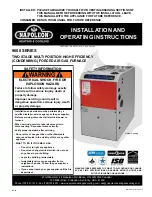
508151-01
Issue 2104
Page 31 of 72
Figure 20. Typical Intake Pipe Connections (Direct Vent Applications)
Pipe size determined in table 7.
2”
2”
2”
2”
or
TOP VIEW
EXHAUST
INTAKE
TRANSITION
3”
*2”
*2”
TRANSITION
3”
*2”
*2”
1-1/2”
or
TRANSITION
NOTE
: 1-1/2” Vent Pipe
Diameter Allowed Only
on 045/070 Units
2”
* When transitioning up in pipe size, use the shortest length of 2” PVC pipe possible.
NOTE
: Exhaust pipe and intake pipe must be the same diameter.
Intake Piping
The A96DS2V furnace may be installed in either direct
vent or non-direct vent applications. In non-direct vent
applications, when intake air will be drawn into the furnace
from the surrounding space, the indoor air quality must be
considered and guidelines listed in Combustion, Dilution
and Ventilation Air section must be followed.
Follow the next steps when installing the unit in Direct Vent
applications, where combustion air is taken from outdoors
and flue gases are discharged outdoors.
The provided
air intake screen must not be used in direct vent
applications (outdoors).
1.
Use cement or a sheet metal screw to secure the
intake pipe to the inlet air connector.
2.
If intake air is drawn from a ventilated crawlspace
(Figure 22) or ventilated attic (Figure 21) the exhaust
vent length must not exceed those listed in Table 20. If
3” diameter pipe is used, reduce to 2” diameter pipe to
accommodate the debris screen.
3.
Route piping to outside of structure. Continue with
installation following instructions given in general
guide lines for piping terminations and intake and
exhaust piping terminations for direct vent sections.
Refer to Table 19A through Table 19C for pipe sizes.
Follow the next two steps when installing the unit in Non-
Direct Vent applications where combustion air is taken from
indoors or ventilated attic or crawlspace and flue gases are
discharged outdoors.
1.
Use field-provided materials and the factory-provided
air intake screen to route the intake piping as shown
in Figure 23. Maintain a minimum clearance of 3”
(76mm) around the air intake opening. The air intake
opening (with the protective screen) should always be
directed forward, or sideways.
2.
Use cement to secure the intake pipe to the connector,
if desired.
If this unit is being installed in an application with
combustion air coming in from a space serviced by an
exhaust fan, power exhaust fan, or other device which
may create a negative pressure in the space, take care
when sizing the inlet air opening. The inlet air opening
must be sized to accommodate the maximum volume
of exhausted air as well as the maximum volume of
combustion air required for all gas appliances serviced
by this space.
CAUTION
















































